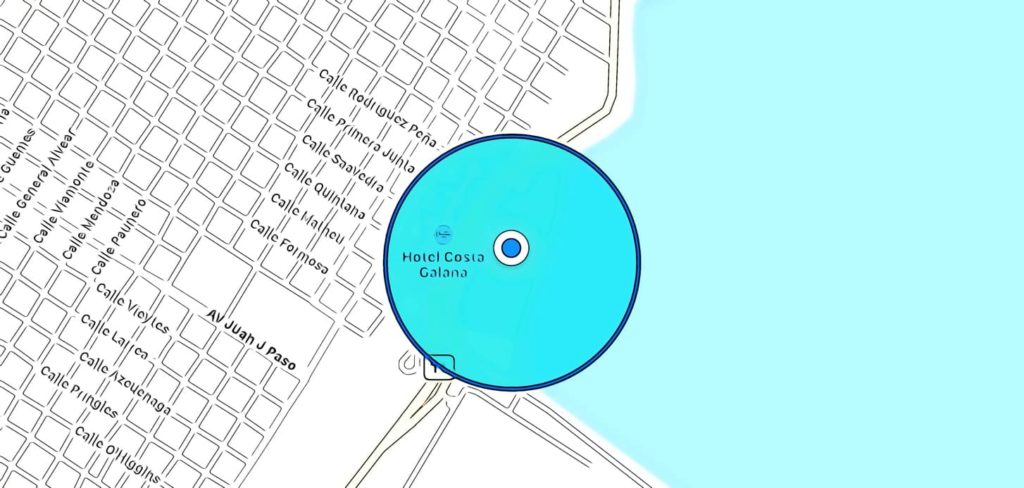Let’s get stuck in with a definition.
Location-based marketing is the practice of using physical location to inform and optimize advertising, communication, targeting, loyalty and attribution.
This sometimes also known as location-based advertising or proximity marketing. At the most basic level, it means creating a one-to-one relationship with the customer. Emphasis is placed on communication in the right place, at the best time and with the relevant message.
Table of Contents
A history of location-based marketing
Despite popular opinion, location-based advertising has been around for a while. Sure, it hasn’t always been backed by the smart technology in your mobile phone. Buy it has existed in some form. Local marketing strategies have been a key part of marketing since the practice began.
It might not have been as effective, but brands have been trying to target users based on location since well before most of you reading this were born. Advertising space has always been purchased based on its location. Be it a metro station in an affluent Paris Arrondissement. Or a teenager holding a sign advertising bagels in a certain street in NYC.

Location-based marketing has developed a lot since then. The underlying technology has advanced at an alarming rate. The ability to understand where audiences go and the ability to market to these is improved.
IP addresses and targeting over Wi-Fi
Location-based marketing has always been around. But, it did up its game in the 90’s once the internet found its way into most family homes.

The dial-up broadband revolution had begun. Most families now had internet access in their home through (a large) desktop computer. For marketers, this meant that advertising could be delivered to a user based on their IP address. Thus marketers could now target based on location, usually an area the size of a postal area.
There are a few problems though. Unless you have a very specific audience in a single geographical area, it’s difficult to ensure that you are targeting the right people. By today’s marketing standards, an entire postal area is just not specific enough.
Another problem that remains is the lack of ability to understand who is on the other end of the screen. When IP targeting was becoming popular, many families had a single computer. The whole family used this. Dad to research which TV to buy next. Mum to book the family holiday. Kids to play online games. This means that ad dollars could easily be wasted. As advertisers were under the impression that they were delivering highly targeted ads.
The beginnings of mobile targeting
Location-based mobile advertising was the next advance in location tech. Phones become truly mobile in the early 2000’s. They were used by the masses and even your gran had one. This meant two things:
It was now possible to advertise to an individual based on physical location whilst they were on the move.
Location-based marketing companies now had a means of segmentation down to a single person.

This was fantastic and all, but the main issues were still accuracy. Whilst the ability to target an individual on the move was well received, issues still remained. The area in which location could be accurately placed was still too large. Mobile targeting via phone masts was a vital step on the road to personalization. However, those in pursuit of accuracy were still frustrated. It often requires a form of phone validation to ensure the right person is reached.
GPS, geofencing and geotargeting
In the late 2000’s smartphones really took off. The first smart devices appeared and with the first iPhone, the race to create powerful mobile devices went mainstream. This led to rapid growth of mobile device adoption with GPS capability.

This changed mobile targeting for good. It was now possible to use a device’s precise GPS satellite positioning to understand device location. This process is known as geofencing, geomarketing, or geotargeting.
A geofence is a virtual boundary that is defined in order to perform a specific response once a device enters or leaves the defined area. More advanced geofencing is possible. An example is focusing on dwell time. Triggering a response when a device is within a geofence for a minimum amount of time.
The geofence allows for mobile targeting to occur on an individual level anywhere. It means that audience segmentation can occur based on individual movement. But it did more than previously possible. It was now far more accurate. This meant that personalization (relevant to location) was now available. Location-based marketing was now personal and precise. Many growth marketing tools, including those offered by agencies like HubSpot agency, can assist you in collecting additional data on your target audience’s buying habits, demographics, and preferences
Satellite problems and indoor confusion.
Location-based mobile targeting improved in accuracy with the geofence. However, on a precision basis, it’s still not perfect.
GPS has issues in some indoor spaces. So it might be incredibly effective at understanding where a person is in their car whilst driving. As soon as they enter an indoor space, GPS can be temperamental.
Some may argue that this level of detail is neither here nor there. But the problem arises when location data providers can’t differentiate between accurate data and inaccurate data. Advertisers and marketers don’t know when the data fuelling their campaigns is incorrect.
Beacons – iBeacon and Eddystone
You thought that it was location-based marketing you were doing before? How very wrong you were. Beacon adoption was a trend that changed location-based marketing and advertising even further.
Thanks to mobile devices and mobile targeting, advertisers would now focus all efforts on accuracy.
Beacons were the natural next step in this journey. Beacons are small Bluetooth devices that can interact with a mobile device. This interaction allows the device to understand exactly where the mobile device is with an accuracy down to 1 meter. Not only does it do this, it can measure positioning on a vertical basis.
There are two main types of beacon technology; iBeacon and Eddystone. These devices are deployed everywhere from shopping malls to sports stadiums.
This was the true beginning of proximity marketing. Delivering personalizable content with accuracy in precise micro-moments. These moments are relevant to the time, place and person. Beacons also allowed for accurate attribution in the offline world.
But what about scalability?
The problem with Beacons is that they require hardware to be deployed. Unlike Geofencing, where geofences can be set around any place that satellites can reach. Beacons must be physically deployed inside a store, or inside a football stadium. So these individual businesses can enjoy a high level of location-based marketing. Once a person leaves these areas they cannot get the same level of location-based insights.
Enter the network approach
The solution to this problem? The proximity network approach. To maintain beacon based, accurate levels across entire cities, it’s essential to collate this location based hardware. That’s what Tamoco’s proximity network is. It’s a complex network of location-based sensors. This allows for mobile targeting, location-based, marketing and location intelligence and insights at a consistently high level. Moreover, this is available whether the device is indoors, outside, on the first floor and so on.
One issue that many proximity marketing companies have had with location-based advertising is with scalability. Creating a proximity network of location allows for this scalability.
Sensory agnostic and a view of the future?
At Tamoco we take a sensory agnostic approach to location-based marketing. We believe that as technology advances, we need to able to adapt to the changing was that advertising, targeting and marketing will change.
A good example of this is the emerging tech around AR. An AR headset or device is still a sensor. Location is a means to an end for targeting through this medium.
By taking an agnostic approach and ensuring our network approach, we ensure that advertising and marketing can keep up with the cutting edge trends. Moreover, we can ensure that this is available with a precision and scale that those original metro advertisers could only dream of. Using location to improve marketing is here to stay.
See how our data is different
James is the head of marketing at Tamoco




Leave a Reply